Stave churches are a special type of medieval wooden church found in Norway.
They are known for their wood-carved decorations and their post and lintel construction, from which they get their name. While many were built throughout northern Europe, only a couple of dozen remain. Most of them (28) are found in Norway.
The most beautiful ones include Borgund, Heddal, and Gol stave church. All of them display impressive Viking craftsmanship and are well worth a visit. Here are the 10 most beautiful stave churches left in Norway
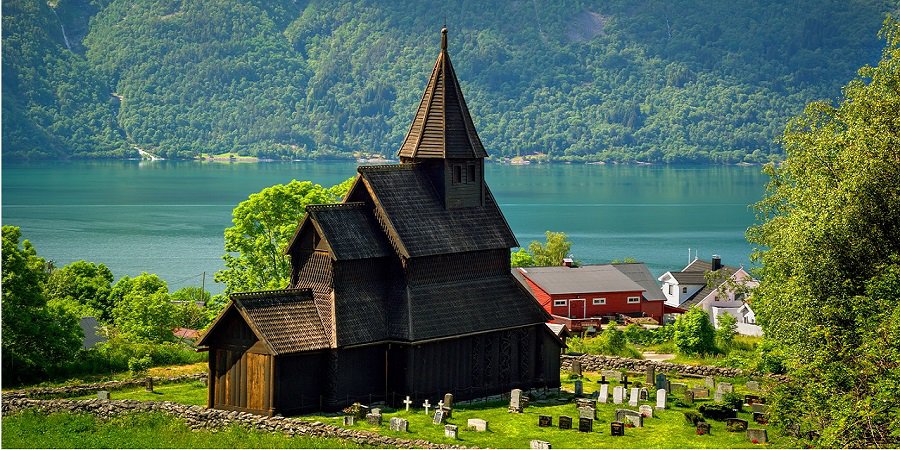
Borgund Stave Church
Borgund stave church is arguably the most beautiful stave church in Norway. The church is located in the small village of Borgund and was built around the year 1200 as the church for Lærdal Parish. The church was probably built as a house of worship for the old Norse gods but was converted into a church as Norway became a Christian nation.
The church has a dark brown wooden outer surface and a shingled roof characteristic of many stave churches. The church has a “cube within a cube” structure each giving rise to its own roof, of which there are 6 in total. On the roof gable, there are 4 carved dragon heads reminiscent of its Viking heritage.
Borgund is located about a 30-minute drive inland from Lærdalsøyri, in the innermost part of the Sognefjord. Traveling from Oslo, it’s about a 4-hour drive following highway 7. Traveling from Bergen, the best route is the 3-hour drive along the E16 Highway. The church is only about a 1-hour drive east from the popular tourist spot Flåm and is well worth a visit if you travel in the area.
Heddal Stave Church
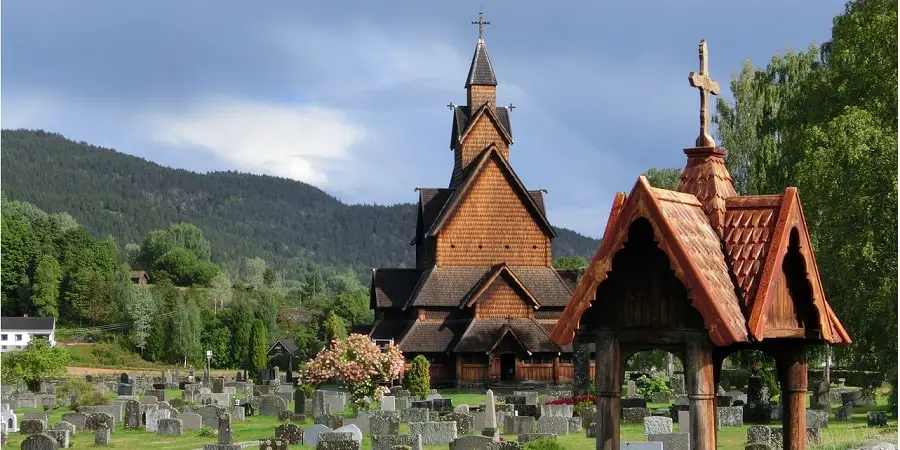
Heddal Stave church, Norway’s largest stave church takes the second spot on this list. It is located at the entrance of the Heddal valley, just west of the town of Notodden in old Telemark county.
It was likely built in the early 13th century (1200-1300) as a Christian house of worship. It has a triple nave structure, each nave having its own shingled roof, giving rise to 3 separate church towers. The interior of the church is marked by the period after the Lutheran reformation in the 16th century
Heddal is located about a 1-hour 40-minute drive west of Oslo along the E134. Traveling from Bergen is a 6-hour drive mostly along the E135 from the west.
The E134 is one of the roads you are likely to take if you are driving from the greater Oslo area to the Hardangerfjord and nearby Folgefonna national park. Also, it is not far from Gaustatoppen, a popular mountain hike in central Telemark. If you are nearby or drive past, it is definitely worth a visit.
Gol Stave Church
Gol stave church is a beautiful 12th-century stave church coming in third on this list. Originally built in Gol in the innermost part of the traditional valley of Hallingdal, it is now located in the open-air Norwegian museum of cultural history on Bygdøy in Oslo.
The church was saved from demolition and relocated in the late 19th century after the erection of a new church in Gol. In addition to its triple nave structure with the characteristic shingled roof, the carved wooden interior is just as impressive.
The Norwegian Museum of cultural history is located on the Bygdøy peninsula, a 20 min bus ride from central Oslo. The museum is open every day from 11 AM to 4 PM.
Hopperstad Stave Church
Coming in at number 4. The Hopperstad stave church is a stunning 12th-century, traditional stave church. It is located in the village of Vikøyri which lies along the southern shore of the Sognefjord.
Dendrechondrological dating proved to show that it is one of the oldest stave churches in Norway. The church still stands where it was originally built back in the Viking age.
That being said, the church was abandoned in the 17th century and underwent significant restoration after being purchased by the society for the preservation of ancient Norwegian monuments in 1880.
The town of Vikøyri and the church is about a 6-hour drive northwest of Oslo along highways 7, 52, and E16. Traveling from Bergen is a short 3-hour drive northeast on the E16 and highway 13.
The church is about a 1-and-a-half-hour drive west of the popular tourist destinations Flåm and Gudvangen. The location makes for great pictures with the nearby fjord and surrounding mountains.
Lom Stave Church
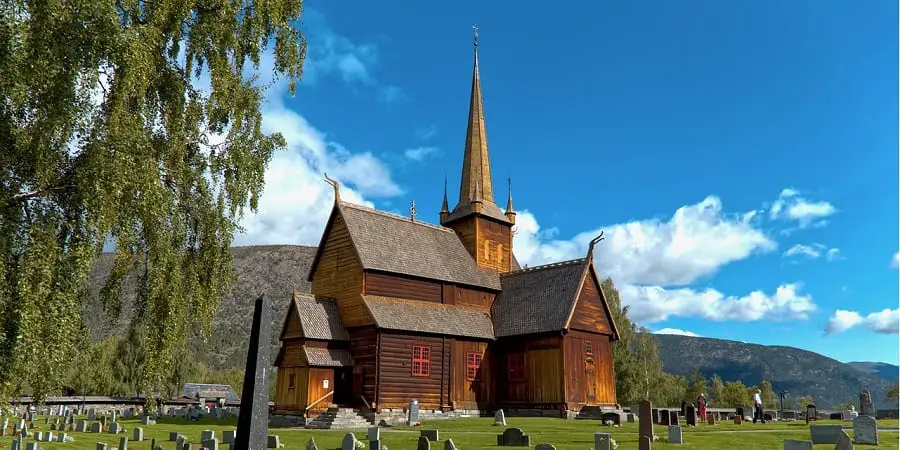
5th on this list is the stave church located in Lom in the central highlands of Norway. The church dates back to the 12 century, however, it was rebuilt into a cruciform church (having the shape of a cross) during the 17th century.
Nevertheless, it has retained most of its traditional stave church features and beauty. In large part due to the rebuild being done in a stave-like fashion. Another restoration in 1933 has kept the church in good condition, and it is one of just a very few stave churches of which the original medieval crest with a dragon head still survives
Lom and its stave church are located about a 4-and-a-half-hour drive northwest of Oslo along the E6 and 15 highways. From Bergen, it is a 6-hour drive northeast along the E15 and highway 55.
Lom is just a 30-minute drive from Jotunheimen national park, Home to Norway’s tallest mountain, Galdøpiggen. If you are in the area for a hike you should stop by the church with its picturesque valley surroundings.
Urnes Stave Church
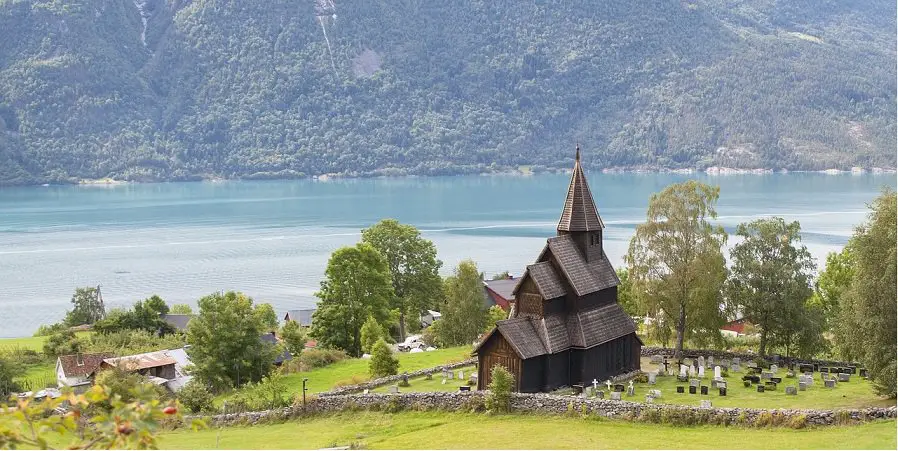
Taking the number 6 spot on this list is Urnes Stave church. While not the most spectacular stave church in terms of appearance, its location along the bank of the Sognefjord makes it very special.
Build sometime during the 12th century, the church itself shares many of the typical stave church features. This includes its structure with a shingled roof and carved wood interior and faded brown wood exterior.
The church is located in the small town of Ornes in the innermost part of the Sognefjord. From Oslo, it is a 5-and-a-half-hour drive northwest along highways E7, 52, and 5. From Bergen, it is an almost 5-hour drive northeast along highway E16.
Located in the innermost part of the Sognefjord, there are several tourist locations nearby. If you are exploring the area, be sure to take a side trip to this beautiful church and the surrounding area.
Eidsborg Stave Church
This beautiful Stave church dating from the 13th century is found in the western part of Telemark county. It is one of the smallest stave churches in Norway but is still a spectacular sight with Its carved wooden details and the shingled roof that blends in perfectly with the surrounding landscape
The church is located close to the town of Dalen, which is a 3-hour drive west of Oslo along highway E134. Brom bergen it’s a 5-hour drive westward along highway 49 and E134.
Highway E134 is one of the mountain passes connecting western and eastern Norway. If you happen to drive past during your trip to Norway, be sure to take a small detour.
Also, Dalen is home to the historic Dalen hotel which is worth a visit in itself. The Luxury Hotel was once a popular locale for European royalty and is one of the largest wooden buildings in Norway and one of the best-preserved hotels of its size from the 1800s.
Ringebu Stave Church
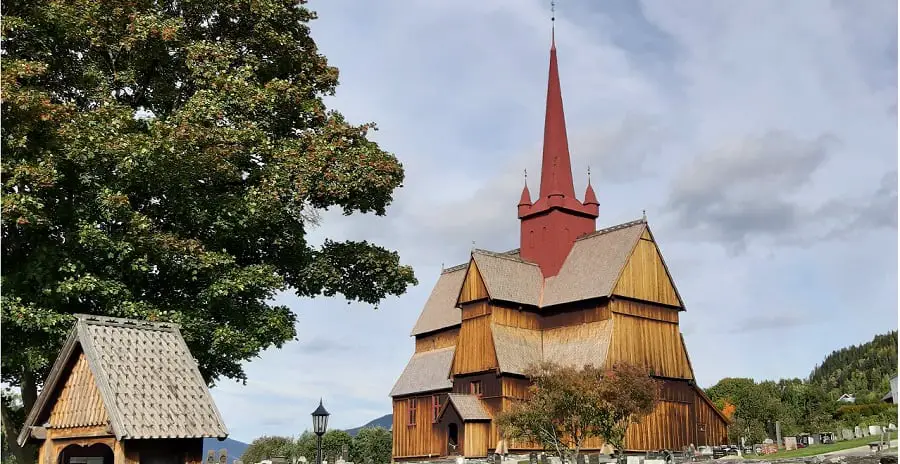
Coming in at number 8, Ringebu Stave church, located on the hillside of the beautiful Gudbrandsdalen Valley is a spectacular sight. The stave church dates from the 13th century but has been subjected to several restorations. One of them was in 1631 when it received its characteristic red tower.
Located on the hillside with the green waters of the gudbrandsdalslågen river flowing in the valley bed below makes this church a spectacular site. If you happen to pass by make sure to stop for a visit.
Ringebu is located about a 3-hour drive north of Oslo along highway E6, One of the main routes heading north to the city of Trondheim. From Bergen, you have to take a 7-hour drive northeastward along highways E16 and 51.
Garmo Stave Church
Taking the 9th spot on this list is Garmo stave church. Originally built in the village of Garmo, Lom in the 12th century, the church was relocated to Lillehammer after being replaced by a new church.
The Re-erected church is now on display in the Maihaugen open-air museum in Lillehammer, central Norway. While it was expanded to a cruciform church, it has retained its stave-church features with the shingled roof with dragon heads on its gables
Lillehammer and the Maihaugen open-air museum is located a 2-and-a-half-hour drive north of Oslo along E6 at the entrance of the Gudbrandsdalen valley. From Bergen, you have to do a 6-and-a-half-hour drive northwest along highway E16.
Hedalen Stave Church
Capturing the last spot on this list, Hedalen stave church dates back to the 12th century. Located in the village of Hedalen in south-central Norway, it was originally a small, single-nave church, which was later expanded.
The expansions have given the church a more “modern” look, lacking the typical shingled roof of other stave churches on this list. That being said, it has kept many of the traditional features, among them is that The front portal is one of the oldest and most richly ornamented in the country, taking the form of three winged dragons.
The village of Hedalen and its church is located about 140 km north of Oslo, which is a 2-hour drive along highway E16. From Bergen, it’s a 5-and-a-half-hour drive west along highway 7.
Other stave churches
While these are the 10 most beautiful stave churches in Norway (in my opinion), there are several others found throughout Norway. These include:
- Flesberg Stave church, Buskerud, 12th century
- Fåvang stave church, Oppland, rebuilt in the 17th century
- Grip stave church, Møre og Romsdal, 15th century
- Haltdalen stave church, Sør-Trøndelag, 12th century
- Hegge stave church, Oppland, 13th century
- Hylestad stave church, Agder, 12th century
- Høre stave church, Oppland, 13th century
- Høyjord stave church, Vestfold, 12th century
- Kaupanger stave church, Sogn og Fjordane 12th century
- Kvernes stave church, Møre og Romsdal, 14th century
- Lomen stave church, Oppland, 12th century
- Nore stave church, Buskerud 12th century
- Øye stave church, Oppland, 12th century
- Reinli stave church, Oppland, 12th century
- Rollag stave church, Buskerud, 12th century
- Rødven stave church, Møre og Romsdal, late 12th/early 13th century
- Røldal stave church, Hordaland, 13th century
- Torpo stave church, Buskerud 12th century
- Undredal stave church, Sogn of Fjordane
- Uvdal stave church, Buskerud, 12th century
Interestingly, there is a Norwegian stave church located in Poland. Vang stave church which was originally located in Valdres, Norway was purchased by the King of Prussia, Frederick William IV, and re-erected in Karpacz in present-day Poland in 1842.
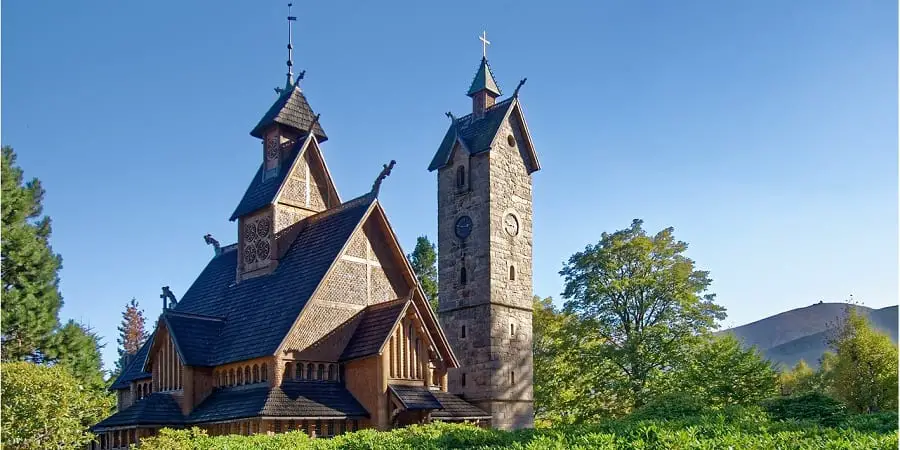
Replicas in Norway and abroad
There are also several replica stave churches built both in Norway and the US. A notable one is Fantoft stave church located in Bergen. The church was erected in 1997 after the original was destroyed by arson in 1992.
In the US you can find replica stave churches in Norway-themed theme parks. One is a replica of the Hopperstad stave church at the hjemkomst center in Minnesota. There is one found in the Scandinavian heritage park in Minot, North Dakota as well as in the Norway pavilion at the Epcot center in the Walt Disney World Resort in Orlando Florida.
Closing remarks
Despite being demolished in large numbers during the 19th century, the handful of stave churches that remain is important monuments in Norwegian culture, history, and craftsmanship.
While there are many churches that are more spectacular throughout the European continent, the fact that some of these old wooden churches date back to the Viking age makes them very special. If you are traveling in Norway I highly recommend you to visit one on this list if you have the chance.

